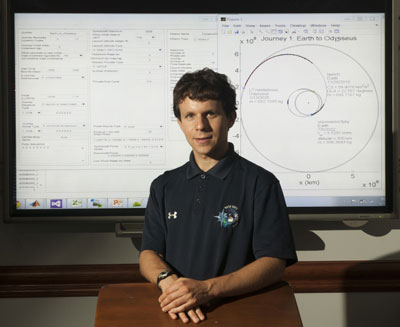| Aug 01, 2013 |
NASA technologist makes traveling to hard-to-reach destinations easier
|
|
(Nanowerk News) Traveling to remote locations sometimes involves navigating through stop-and-go traffic, traversing long stretches of highway and maneuvering sharp turns and steep hills. The same can be said for guiding spacecraft to far-flung destinations in space. It isn’t always a straight shot.
|
|
A NASA technologist has developed a fully automated tool that gives mission planners a preliminary set of detailed directions for efficiently steering a spacecraft to hard-to-reach interplanetary destinations, such as Mercury, Jupiter, Saturn, and most comets and asteroids.
|
|
The tool, the Evolutionary Mission Trajectory Generator “offers a paradigm shift from what we normally do,” said Jacob Englander, a technologist at NASA’s Goddard Space Flight Center in Greenbelt, Md., who devised a concept for his computer-based tool while a doctorate student at the University of Illinois in Champaign. “EMTG will be used, and already is being used, to develop trajectories for proposed Goddard missions that cannot be designed using any other current tool.”
|
 |
| The image behind NASA technologist Jacob Englander shows the trajectory to Odysseus, a Trojan asteroid. Englander used his new orbit-determination tool to create the design (not associated with any mission or mission proposal) because a colleague suggested Odysseus was a difficult-to-reach target.
|
|
Science Unto Itself
|
|
Determining mission configurations, which EMTG accomplishes on a standard desktop computer, is a science unto itself.
|
|
Early interplanetary missions were confined to Earth’s immediate neighbors: first Venus, then Mars. The total change in velocity, which on Earth is akin to stepping on the gas to propel your vehicle even faster, was low enough that direct flights were possible using 1960s chemical-based thruster technology. Travel to more distant destinations, however, required a larger change in velocity, and therefore more propellant — not always possible with mass-constrained spacecraft.
|
|
A way to overcome that obstacle was executing a planetary flyby, a slingshot-type maneuver where a spacecraft uses the relative movement and gravity of a planet or other celestial body to alter its path and speed. First proposed in 1961, NASA has used this technique in interplanetary missions since Mariner 10 in 1964.
|
|
But determining the number and locations of planetary flybys to gain gravitational assists is easier said than done — a process requiring the computation of complex mathematical equations calculated by powerful computers.
|
|
What makes Englander’s technology unique, he said, is the fact that mission developers needn’t first make an educated guess as they currently do of a possible spacecraft trajectory or path to a particular target. Unlike other trajectory-design tools, “ours is fully autonomous,” explained Englander, who used NASA’s Center Innovation Fund support to create the EMTG’s algorithms and software.
|
|
No Noodling Required
|
|
Without any forethought or noodling, all mission developers need to do with his tool is input a series of parameters, such as the spacecraft’s point of origin, its final destination and physical characteristics, as well as a range of launch dates and flight times.
|
|
The software tool then uses these data points to calculate the most efficient trajectory, including the number of flybys, for reaching a celestial target, whether it is a moon in the outer solar system or a Kuiper Belt object. Better yet, Englander said, the tool can calculate many different possible trajectories at a time, depending on which parameters a mission planner uses. “This dramatically reduces time to calculate a mission configuration,” he added.
|
|
The tool, which comes in two different versions to calculate the trajectories of chemically (high-thrust) or electrically (low-thrust) propelled spacecraft, is effective, too, Englander said. “The high-thrust (chemical propulsion) version of this EMTG has already achieved a number of successes,” Englander said.
|
|
Without knowing the precise maneuvers that NASA’s Cassini/Huygens mission used to reach Saturn and its moons, Englander used his tool to calculate the mission’s flyby sequence and trajectory. “It took only two days of computing time on an ordinary desktop computer and no other user input to reproduce the Cassini mission configuration — a trajectory that originally took extremely talented designers many months to develop.”
|
|
Now that he has shown its effectiveness, Englander said he plans to further improve the EMTG’s fidelity. “The purpose of EMTG is to enable the design of new types of missions and reduce costs. Anyone can use this tool.”
|

